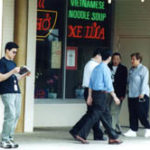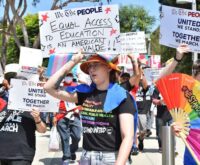21 of 24 Division I historically black colleges face possible postseason bans in 2016
By Jake New
InsideHigherEd.com, June 2, 2015 — Ten of the 16 institutions with teams facing National Collegiate Athletic Association penalties this year for poor academic performance are historically black colleges and universities.
The ratio is striking, but not surprising. HBCUs are often the hardest hit by the NCAA’s academic requirements. Last year, teams at 12 black colleges were penalized for not meeting the required academic progress rate — the NCAA’s four-year metric for measuring the academic performance of teams — and eight were banned from participating in postseason games. In 2013, 15 of the 18 teams that received postseason bans were from HBCUs.
When a new minimum APR kicks in next year, the NCAA’s standards will grow even farther out of reach for struggling HBCUs. An analysis of the most recent academic progress rates reveals that, under the new rule, more than 50 teams at 21 of the 24 historically black colleges and universities in Division I could be banned from participating in postseason games.
For the last two years, the NCAA has been phasing in the new minimum of the metric. The previous minimum for postseason play was 900. For most colleges, the standard is now 930.
HBCUs and other “limited resource” institutions have been largely exempt from that rule so far, after William Harvey, president of Hampton University, wrote a proposal in 2012 that led to the NCAA giving HBCUs more time to meet the new standard. But time is running out. Black-college officials have just one year left to increase the APRs of their teams to 930.
There are currently two standards HBCUs must meet: a higher benchmark (925 out of 1,000) and a lower benchmark (900 out of 1,000). Teams that fall below the former in any given year are given less-severe penalties, and teams that fall below the latter for consecutive years are given stackable and more-severe penalties, such as reduction of practices and games, or even coaching suspensions.
Teams that don’t reach the 900 minimum are also banned from participating in postseason games. In all, more than 20 teams at 10 HBCUs were penalized this year for failing to meet the current standards. About 15 teams at nine HBCUs are banned from next year’s postseason for not meeting the 900 minimum. If every team at all Division I HBCUs were expected to meet the new 930 standard, as they will be starting in 2016, the number of HBCUs facing postseason bans would more than double.
Savannah State University could face postseason bans for its football, men’s and women’s basketball, and baseball teams. Morgan State University, currently facing no postseason bans, could see bans for its football and men’s basketball teams. Prairie View A&M University, already banned in the postseason in men’s indoor and outdoor track and field, could also be banned from postseason play in football and men’s basketball. Grambling State University — an institution once renowned for its athletics that in recent years has faced declining interest, as well as lawsuits and budget cuts — is currently in the clear with its football, men’s basketball and women’s basketball teams all possessing APRs above 900. None of them, however, reach the 930 minimum.
Grambling’s football team is close, however, with an APR of 927. Indeed, many HBCU teams have made improvements in recent years. At Hampton University, every major team would make the cut. At Howard University, Jackson State University and North Carolina Central University, certain teams have some of the highest APRs in their sport. Six programs in the all-HBCU Southwestern Athletic Conference have APRs in the top 10 percent of Division I.
According to the NCAA, the average single-year APR for teams at limited-resource schools is now 963, up 16 points in the past 4 years.
“The academic performance of limited-resource schools is improving faster than that of any other part of the Division I membership,” Mark Emmert, president of the NCAA, said in a statement. “The goal of the academic performance program is to encourage teams to improve academically, not punish those who underperform. We will work with HBCUs and limited-resource schools to make sure their college athletes have every opportunity to succeed academically.”
Over the last few years, the NCAA has offered HBCUs financial support in reaching the new goal. Through a pilot project called the Accelerating Academic Success Program, institutions can apply for $300,000 grants. The funding goes to six different HBCUs each year.
How the money is used depends on the individual needs of an institution. An HBCU with a small number of academic advisers and tutors, for example, could use the money to hire more.
The challenge HBCUs face is not one simply of limited resources. Compared to students at wealthier, predominantly white institutions, HBCU students — athletes and otherwise — are often underprepared for the challenges of college. The average overall graduation rate at HBCUs, which tend to focus on enrolling first-generation and other nontraditional students, is about 40 percent. A 2013 study released by the NCAA found that only about 61 percent of African-American male college athletes graduate within six years. More than 80 percent of white athletes graduate in that same time span. According to the NCAA, an APR of 930 means that about half a team is on track to graduate.
Jennifer Burroughs, a spokeswoman for the NCAA, said the association is aware of just how many HBCUs are below the new standard, but that it is still hopeful that the programs will “meet the benchmark or have a plan to do so by 2016.” The NCAA recently assembled a working group composed of officials from limited-resource institutions to generate recommendations about what can be done to help. The group’s recommendations aren’t due until January 2016.
The help is appreciated, HBCU officials said, but they said what they really need is more time to make sure what steps they’ve taken in recent years will help in the long term. At its annual spring meeting last week, the Southwestern Athletic Conference voted to require academic support staff at member institutions to become members of the National Association of Academic Advisors for Athletics, a requirement that now only has one year to start showing results.
As the new NCAA rule is phased in, some teams at HBCUs are already being affected. Last week, the NCAA banned Savannah State’s women’s basketball team from playing in postseason games. The team’s most recent multiyear APR is 905. Once the new minimum is required for all sports, 10 of Savannah State’s 15 NCAA teams could face such a ban. Under the previous rule, only the football team would have been banned from postseason play.
“When you’re in an organization, the rules are the rules, but ‘fair’ is not a word I would use to describe this,” said Sterling Steward, athletics director at Savannah State. “I think the grace period should have been extended. We are dealing with a lot of first-generation students whose transition to college sometimes is a little difficult. Our intent is to have each one of our teams reach APRs of 1,000. We want to be at 1,000. But realistically, you’re at the mercy of the students.”










